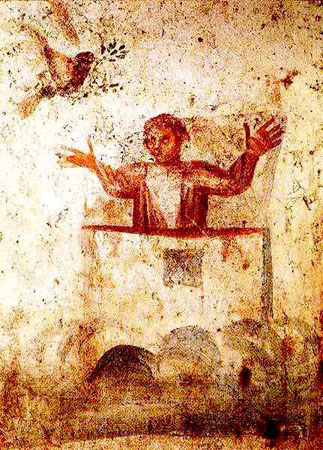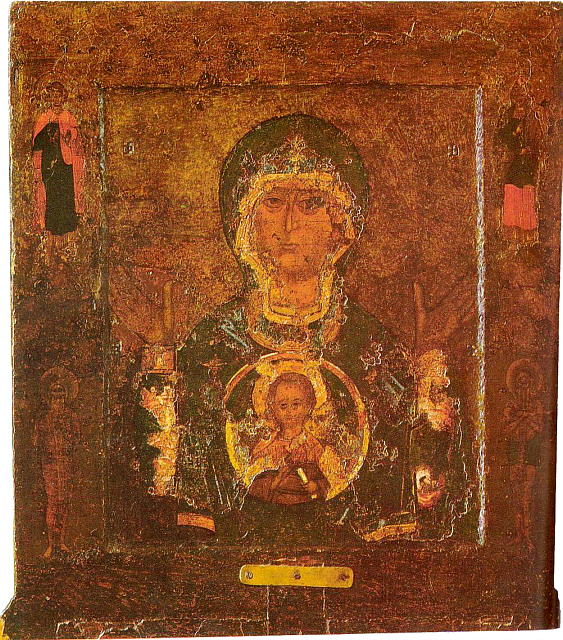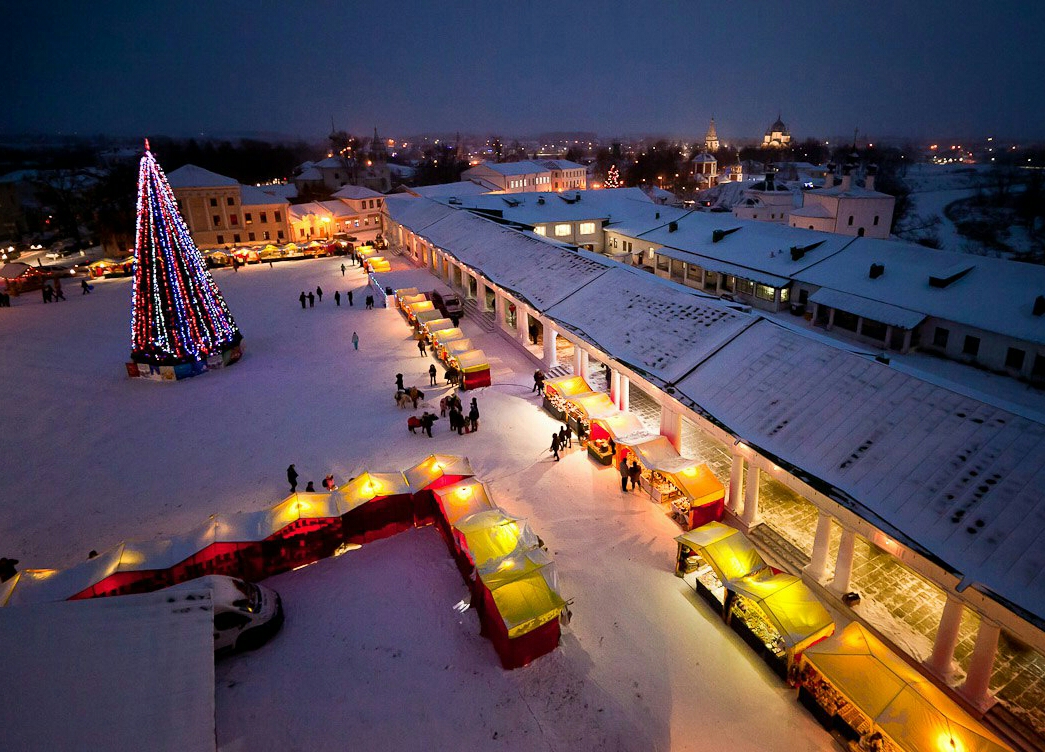|
Our Lady Of The Sign (Novgorod)
Znа́meniye (Russian: ''Зна́мение'') or Our Lady of the Sign is an icon in the orans style, dated at the first half of the 12th century. The icon was painted in medieval Novgorod. It is one of the most revered icons of the Russian Orthodox Church and the main holy of Russian North-West. In past the icon was the main icon of the Novgorod Republic and the symbol of Novgorod sovereignty and republicanism due to the event that has glorified the icon. Description The icon symbolizes the pregnancy of the Virgin: it shows Our Lady with hands raised for praying and the figure of the holy infant in her chest in the circle (orans type of icons). The icon is 2-sided: saint Joachim and saint Anne in praying are pictured on the back side. It has a shaft which for an icon indicates the ability to be carried outside. In the 17th century the paint was refreshed: Macarius, the metropolitan of Moscow, is believed to be the possible executor). The initial ancient paint is retained o ... [...More Info...] [...Related Items...] OR: [Wikipedia] [Google] [Baidu] |
Orans
Orans (/ˈoː.rans/), a loanword from Medieval Latin ''ōrāns'' translated as ''one who is praying or pleading'', also orant or orante, as well as lifting up holy hands, is a posture or bodily attitude of prayer, usually standing, with the elbows close to the sides of the body and with the hands outstretched sideways, palms up. The orans posture of prayer has a Scriptural basis in : "I desire, then, that in every place the men should pray, lifting up holy hands without anger or argument" (NRSV). It was common in early Christianity and can frequently be seen in early Christian art, being advised by several early Church Fathers, who saw it as "the outline of the cross". In modern times, the orans position is still preserved in Oriental Orthodoxy, as when Coptic Christian believers pray the seven canonical hours of the Agpeya at fixed prayer times; The orans also occurs within parts of the Catholic, Oriental Orthodox, Eastern Orthodox, Lutheran, and Anglican liturgies, Pentecos ... [...More Info...] [...Related Items...] OR: [Wikipedia] [Google] [Baidu] |
Principality Of Murom
The Principality of Murom was a medieval Rus' lordship based on the city of Murom, now in Vladimir Oblast, Russia. Murom lay in an area that was strongly Finnic and for much of its medieval history, located in the homeland of the Muromians. It appears to have been an important Finnic settlement in the ninth-century, with an archaeologically noticeable Scandinavian presence from the tenth-century, as evidenced by Frankish swords, a tortoiseshell brooch and a sword chape. The ''Primary Chronicle'' alleges that Murom came under Rus' control in the eighth-century. Gleb Vladimirovich, son of Vladimir the Great, ruled the principality in the early eleventh-century. Murom was part of the territory of the Principality of Chernigov in the late eleventh-century, controlled by the Sviatoslavichi clan, the descendants of Iaroslav the Wise; probably it was retained by Vsevolod Iaroslavich even after this Prince of Chernigov became Grand Prince in 1076. Oleg Sviatoslavich, grandson ... [...More Info...] [...Related Items...] OR: [Wikipedia] [Google] [Baidu] |
Byzantine Calendar
The Byzantine calendar, also called the Roman calendar, the Creation Era of Constantinople or the Era of the World ( grc, Ἔτη Γενέσεως Κόσμου κατὰ Ῥωμαίους, also or , abbreviated as ε.Κ.; literal translation of Ancient Greek Roman year since the creation of the universe), was the calendar used by the Eastern Orthodox Church from c. 691 to 1728 in the Ecumenical Patriarchate. "Οικουμενικόν Πατριαρχείον", ΘΗΕ, τόμ. 09, εκδ. Μαρτίνος Αθ., Αθήνα 1966, στ. 778. "Ecumenical Patriarchate". ''Religious and Ethical Encyclopedia''. Vol. 9., Athens, 1966. p. 778. It was also the official calendar of the Byzantine Empire from 988 to 1453 and of Kievan Rus' and Russia from c. 988 to 1700. This calendar was used also in other areas of the Byzantine commonwealth such as in Serbia, where it is found in old Serbian legal documents such as Dušan's Code, thus being referred to as the Serbian Calendar a ... [...More Info...] [...Related Items...] OR: [Wikipedia] [Google] [Baidu] |
Old Novgorod Dialect
Old Novgorod dialect (russian: древненовгородский диалект, translit=drevnenovgorodskij dialekt; also translated as Old Novgorodian or Ancient Novgorod dialect) is a term introduced by Andrey Zaliznyak to describe the dialect found in the Old East Slavic birch bark writings ("berestyanaya gramota"). Dating from the 11th to 15th centuries, the letters were excavated in Novgorod and its surroundings. For linguists, Old Novgorodian is particularly of interest in that it has retained some archaic features which were lost in other Slavic dialects, such as the absence of second palatalization. Furthermore, letters provide unique evidence of the Slavic vernacular, as opposed to the Church Slavonic which dominated the written literature of the period. Most of the letters feature informal writing such as personal correspondence, instructions, complaints, news, and reminders. Such widespread usage indicates a high level of literacy, even among women and children. ... [...More Info...] [...Related Items...] OR: [Wikipedia] [Google] [Baidu] |
Old East Slavic
Old East Slavic (traditionally also Old Russian; be, старажытнаруская мова; russian: древнерусский язык; uk, давньоруська мова) was a language used during the 9th–15th centuries by East Slavs in Kievan Rus' and its successor states, from which the Belarusian, Russian, Rusyn, and Ukrainian languages later evolved. Terminology The name of the language is known as ''Old East Slavic'', in reference to the modern family of East Slavic languages. Its original speakers were the Slavic tribes inhabiting territories of today's Belarus, the western edge of Russia, and western and central Ukraine. However, the term ''Old East Slavic'' is not universally applied. The language is traditionally also known as ''Old Russian'', (; russian: древнерусский язык, translit=drevnerusskij jazyk), however the term has been described as a misnomer, because the initial stages of the language which it denotes predate the dialec ... [...More Info...] [...Related Items...] OR: [Wikipedia] [Google] [Baidu] |
The Exodus
The Exodus (Hebrew: יציאת מצרים, ''Yeẓi’at Miẓrayim'': ) is the founding myth of the Israelites whose narrative is spread over four books of the Torah (or Pentateuch, corresponding to the first five books of the Bible), namely Exodus, Leviticus, Numbers, and Deuteronomy. The majority of modern scholars date the composition of the Torah to the Middle Persian Period (5th century BCE). Some of the traditions contributing to this narrative are older, since allusions to the story are made by 8th-century BCE prophets such as Amos and Hosea. The consensus of modern scholars is that the Bible does not give an accurate account of the origins of the Israelites, who appear instead to have formed as an entity in the central highlands of Canaan in the late second millennium BCE from the indigenous Canaanite culture. Most modern scholars believe that the story of the Exodus has some historical basis, but that any such basis has little resemblance to the story told in th ... [...More Info...] [...Related Items...] OR: [Wikipedia] [Google] [Baidu] |
Moses
Moses hbo, מֹשֶׁה, Mōše; also known as Moshe or Moshe Rabbeinu ( Mishnaic Hebrew: מֹשֶׁה רַבֵּינוּ, ); syr, ܡܘܫܐ, Mūše; ar, موسى, Mūsā; grc, Mωϋσῆς, Mōÿsēs () is considered the most important prophet in Judaism and one of the most important prophets in Christianity, Islam, the Druze faith, the Baháʼí Faith and other Abrahamic religions. According to both the Bible and the Quran, Moses was the leader of the Israelites and lawgiver to whom the authorship, or "acquisition from heaven", of the Torah (the first five books of the Bible) is attributed. According to the Book of Exodus, Moses was born in a time when his people, the Israelites, an enslaved minority, were increasing in population and, as a result, the Egyptian Pharaoh worried that they might ally themselves with Egypt's enemies. Moses' Hebrew mother, Jochebed, secretly hid him when Pharaoh ordered all newborn Hebrew boys to be killed in order to reduce the populati ... [...More Info...] [...Related Items...] OR: [Wikipedia] [Google] [Baidu] |
Phelonion
The phelonion (Greek: , plural, , ''phailónia''; Latin: '' paenula'') is a liturgical vestment worn by a priest of the Byzantine Christian tradition. It is worn over the priest's other vestments and is equivalent to the chasuble of Western Christianity. History Like the chasuble, the phelonion was originally a sort of poncho, a conical round vestment with a hole in the middle for the head, which fell to the feet on all sides. It derived from the Roman civilian '' paenula'', and it was made of wool, silk, or linen. Unlike the chasuble, it was worn at all liturgical functions, not only at the Eucharist. It was in use as early as the sixth century for priests, bishops, and also minor orders, and can be seen in the mosaics in Ravenna and the Euphrasian Basilica in Porec. The phelonion is depicted in the Menologion of Basil II, dating to 1000 AD. It shape evolved, and it was folded above the elbows to free the arms and hands. In its present form (dating from about the fifteenth ... [...More Info...] [...Related Items...] OR: [Wikipedia] [Google] [Baidu] |
Desyatinny Monastery
The Desyatinny Monastery (russian: Десяти́нный монастырь) is an inactive monastery or convent in Veliky Novgorod ( Russia), one of eight ancient monasteries of Novgorod Republic. The Desyatinny Monastery now has a regular square-shaped perimeter. The monastery's complex was developed over a lengthy period and now includes objects constructed in periods from the 14th to the 20th centuries. It was finally completed at the beginning of the 20th century but was closed in 1918 by the Soviet government. Some buildings, including both churches and part of the monastery wall, were lost in the 20th century during World War II and the anti-religious campaign, with the result that the monastery is preserved fragmentarily. Never considered particularly important, it was subjected to rebuilding many times. Built to symbolize and immortalize the miracle of historical significance for the Novgorod Republic, until the present day, the monastery in fact has undertaken cert ... [...More Info...] [...Related Items...] OR: [Wikipedia] [Google] [Baidu] |
Church Of The Transfiguration On Ilyina Street
The Church of the Transfiguration of the Savior (russian: Церковь Спаса Преображения на Ильине улице) is a former Russian Orthodox Church that stands on Ilyina (Elijah) Street in Veliky Novgorod just east of the Marketplace. The current building was built in 1374 and frescoed by Theophanes the Greek (Feofan Grek or Феофан Грек in Russian) in 1378. Substantial portions of those frescoes still remain, including the Christ Pantocrator in the dome, a number of saints inside the south entrance, and The Old Testament Trinity in the western vestry, as well as others.G. I. (Gerol'd Ivanovich)Vzdornov, ''Freski Feofana Greka v tserkvi Spasa Preobrazheniia v Novgoroda: k 600-letiu sushchestvovaniia fresok 1378-1978'' (Moscow: Iskusstvo 1976); Idem, ''Feofan Grek'' (Moscow: Iskusstvo, 1983); Viktor Lazarev, ''Feofan Grek i ego shkola'' (Moscow: Iskusstvo, 1961). The current building is now a museum, part of the Novgorod State Museum-Preserve. ... [...More Info...] [...Related Items...] OR: [Wikipedia] [Google] [Baidu] |
Ilya (Archbishop Of Novgorod)
Ilya of Novgorod, also known as Ioann (John) of Novgorod (russian: Иоанн Новгородский, his name upon entering the Great Schema and the name by which he is known in Russian Orthodox hagiography), was Archbishop of Novgorod from 1165 to his death in 1186. Life The son of a priest, Ilya was himself priest of the Church of St. Blaise, south of the Novgorod Kremlin. The church was destroyed, rebuilt in 1407, destroyed during the Second World War and rebuilt again. Ilya was probably his first monastic name, and his baptismal name is not known. Ilya was appointed bishop of Novgorod by Metropolitan Ioann of Kiev in 1165. He was the first to hold the title of archbishop in Novgorod after the office was elevated to the archiepiscopal dignity a few months later. Niphont held the title as a personal honor. Ilya carried out a number of construction projects in Novgorod along with his brother, Gavril (also known as Grigorii), who succeeded him as archbishop (1186–1193) a ... [...More Info...] [...Related Items...] OR: [Wikipedia] [Google] [Baidu] |
Suzdal
Suzdal ( rus, Суздаль, p=ˈsuzdəlʲ) is a town that serves as the administrative center of Suzdalsky District in Vladimir Oblast, Russia, which is located on the Kamenka River, north of the city of Vladimir. Vladimir is the administrative center of the surrounding oblast. As of the 2021 Census, its population was 9,286. Suzdal is one of the oldest Russian towns. In the 12th century, it became the capital of the principality, while Moscow was merely one of its subordinate settlements. Currently, Suzdal is the smallest of the Russian Golden Ring towns, but it has more than 40 historically important monuments and 200 architectural sites. Several of these sites are listed as UNESCO World Heritage Sites. History The town's history dates back probably to 999 or 1024, and in 1125 Yury Dolgoruky made Suzdal the capital of the Rostov-Suzdal principality. Suzdal began to function as a capital at the time when Moscow was still a cluster of cowsheds. In 1157, And ... [...More Info...] [...Related Items...] OR: [Wikipedia] [Google] [Baidu] |









